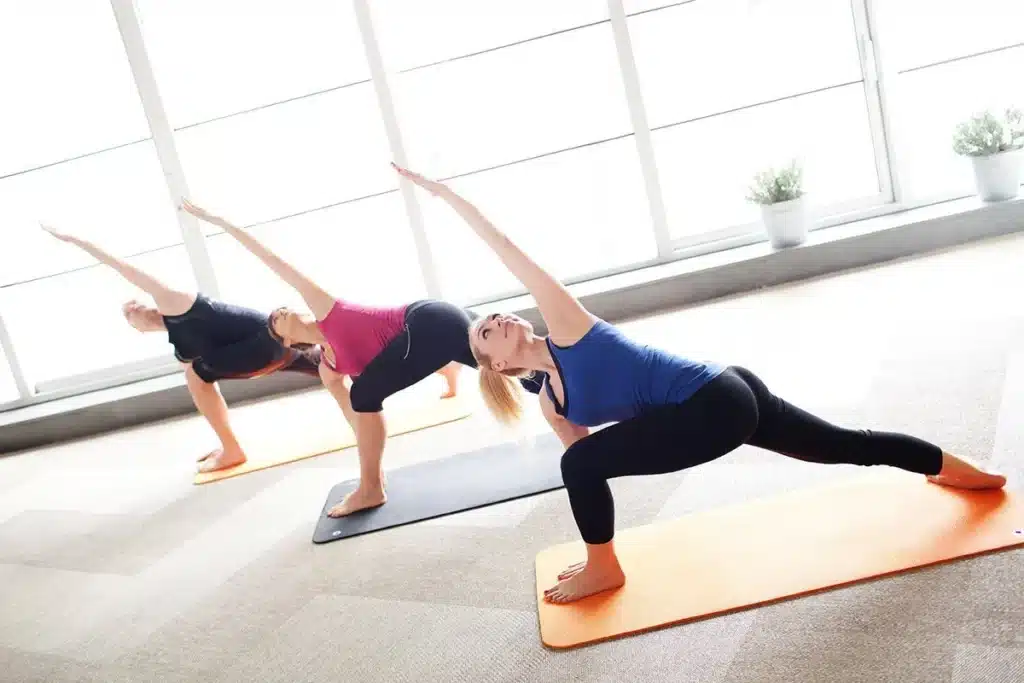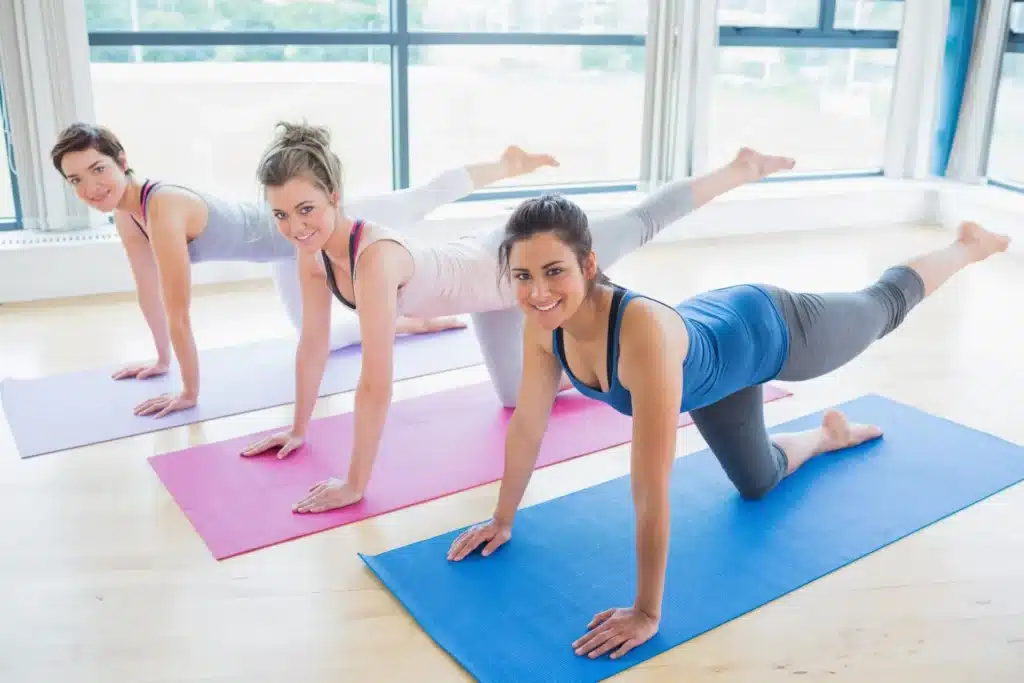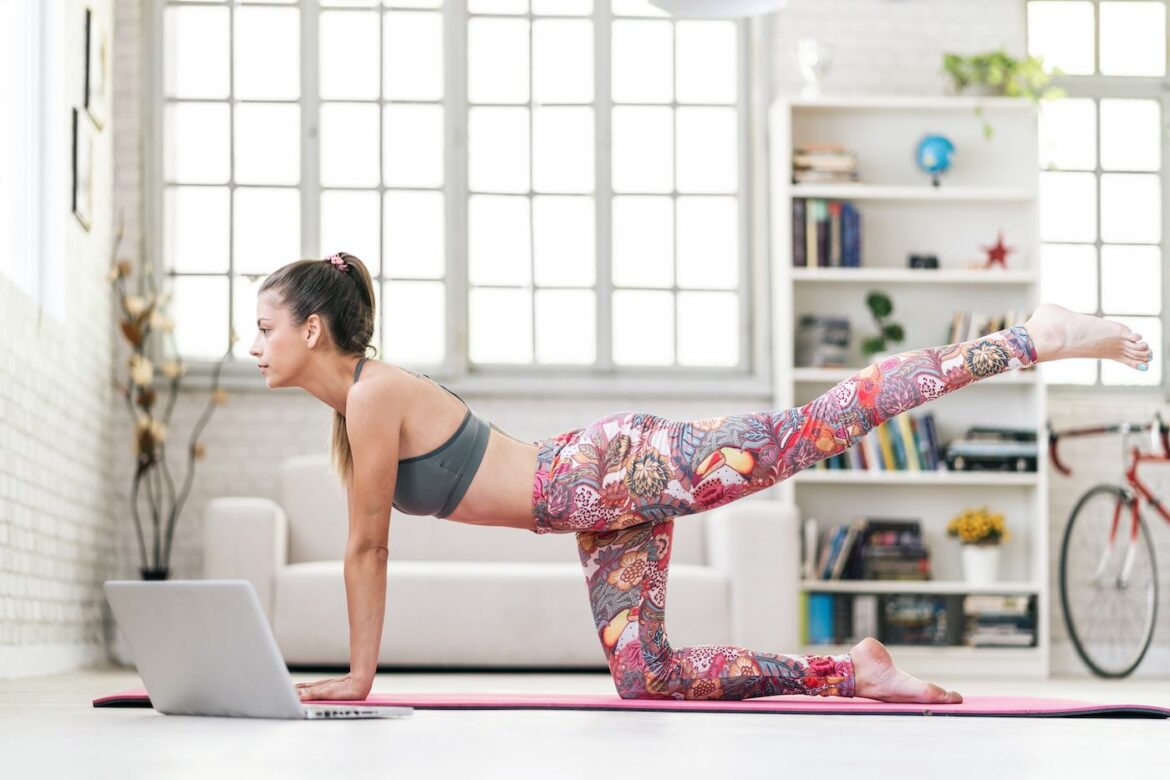Introduction
Is Pilates Good For Toning: In the ever-evolving world of fitness, individuals seeking effective and sustainable ways to tone their bodies often stumble upon various exercise modalities. One such method that has gained considerable popularity in recent years is Pilates. But what exactly is Pilates, and is it truly effective for toning the body. This question has piqued the curiosity of many fitness enthusiasts and beginners alike. In this exploration, we will delve into the world of Pilates to understand its principles, benefits, and whether it indeed serves as a valuable tool for achieving the coveted goal of body toning. So, let’s embark on this journey to uncover whether Pilates is a worthwhile endeavor for those looking to sculpt their physique.
Pilates is a physical fitness system that was developed by Joseph Pilates in the early 20th century. It focuses on improving flexibility, strength, and overall body awareness. Pilates exercises are typically done on a mat or with specialized equipment, such as the reformer or Cadillac. Pilates is based on several core principles, including concentration, control, centering, precision, breath, and flow. These principles are designed to engage both the mind and body in a coordinated manner, promoting proper form and alignment.
There are different styles and levels of Pilates, from beginner to advanced, and even specialized workouts for specific goals like toning. Mat Pilates and equipment-based Pilates offer options to cater to various fitness levels and preferences. While Pilates can be effective for toning, it’s important to note that diet and cardiovascular exercise also play crucial roles in achieving a toned body. A balanced diet and regular aerobic workouts can complement Pilates to help you reach your toning goals more effectively.

Can you get toned with just Pilates?
So, simple answer to the question is yes, Pilates can tone your body.
Toning with Pilates
Core Strength: Pilates places a significant emphasis on the core muscles, which include the abdominals and lower back. Consistent practice of Pilates helps sculpt and tone these muscles, leading to a flatter, more defined midsection.
Muscle Engagement: Pilates incorporates various exercises that engage multiple muscle groups simultaneously. For instance, exercises like the plank, leg circles, and the hundred require the activation of not only the core but also the legs, arms, and back muscles. This holistic approach contributes to overall muscle tone.
Long, Lean Muscles: Unlike some forms of resistance training that can bulk up muscles, Pilates promotes long, lean muscles. This results in a toned appearance without excessive bulk, making it an appealing option for those seeking an elegant, streamlined physique.
Improved Posture: Pilates also focuses on improving posture by strengthening the muscles that support the spine. As posture improves, the body’s alignment enhances, giving the illusion of a more toned and poised physique.
How often should I do Pilates to get toned?
If you’re looking to create change and develop whole body fitness using the Pilates method, three times a week is often the sweet spot. More focused concentration and continued practice creates changes in the brain that will support more optimal movement patterning.
Personal Goals
The frequency of your Pilates sessions largely depends on your specific fitness goals. If you aim to achieve a moderate level of muscle tone and overall fitness, practicing Pilates two to three times a week may suffice. This frequency can help maintain your current level of tone and improve overall strength and flexibility.
For individuals seeking a higher degree of muscle definition and toning, a more frequent Pilates practice, such as four to five times a week, may be necessary. Keep in mind that the more often you engage in Pilates, the quicker you may see results in terms of muscle tone and body composition.
Experience Level
Your experience level with Pilates also influences the ideal frequency. Beginners may need to start with two to three sessions per week to allow their bodies to adapt to the movements, build foundational strength, and develop proper form. As you become more proficient, you can gradually increase the frequency of your sessions.
Balance with Other Activities
Consider how Pilates fits into your overall fitness routine. If Pilates is your primary form of exercise, you may need to practice it more frequently to achieve your toning goals. However, if you complement your Pilates practice with other forms of exercise, such as cardio, strength training, or yoga, you may require fewer Pilates sessions to attain your desired level of muscle tone.
How many days a week should you do Pilates to get toned?
3-4 times per week
Pilates Workout Schedule
This may seem like a lot, but remember that each session is only around 30-60 minutes long. You can easily fit 3 reformer Pilates workouts into your schedule! Or, if you’re looking to tone your muscles and build strength, 3-4 times per week is a good place to start.
Your Toning Goals
The frequency of your Pilates practice depends largely on your specific toning objectives. If you’re looking for modest muscle tone enhancement and overall fitness maintenance, engaging in Pilates sessions two to three times a week may suffice. This frequency can help you maintain your current muscle tone and improve your overall strength and flexibility.
For those aiming for a higher degree of muscle definition and toning, a more frequent Pilates practice, such as four to five times a week, may be necessary. Remember that the more regularly you practice Pilates, the faster you’re likely to see visible results in terms of muscle tone and body composition.
Experience Level
Your experience level with Pilates plays a crucial role in determining the appropriate frequency. Beginners might need to start with two to three sessions per week to allow their bodies to acclimate to the movements, build foundational strength, and develop proper form. As you become more proficient, you can gradually increase the frequency of your sessions.
Integration with Other Activities
Consider how Pilates fits into your overall fitness routine. If Pilates constitutes your primary form of exercise, you may need to practice it more frequently to achieve your toning goals. Conversely, if you complement your Pilates practice with other forms of exercise, such as cardio, strength training, or yoga, you might require fewer Pilates sessions to attain your desired level of muscle tone.
Can you get a toned stomach from Pilates?
Pilates exercises are a great way to tighten and tone your abs and give you the “ beach body” that you’ve been missing. Pilates exercises work by engaging and strengthening the internal abdominal muscles that are responsible for giving you a flatter, more toned stomach.
How Pilates Helps Tone the Stomach
Targeted Exercises: Pilates incorporates a variety of exercises that specifically target the abdominal muscles. Movements like the Pilates Hundred, leg circles, and the teaser work to engage and strengthen the rectus abdominis and obliques, helping you achieve a flatter and more defined stomach.
Improved Muscle Endurance: Pilates focuses on slow, controlled movements that require you to maintain muscle engagement throughout each exercise. This helps build endurance in the abdominal muscles, contributing to a toned appearance over time.
Emphasis on Core Stability: Pilates places a significant emphasis on core stability and proper alignment. Strengthening the deeper core muscles helps improve posture and reduces the risk of back pain while simultaneously enhancing the aesthetic aspect of a toned stomach.
Streamlined Results: Pilates is designed to lengthen and tone muscles without adding bulk. This results in a leaner and more sculpted appearance, ideal for those who want toned abs without excessive muscle mass.
Is yoga or Pilates better for toning?
When comparing the two types of exercise, both Pilates and yoga will increase the body’s tone, or resting muscle strength. Pilates has the ability to use both body weight and additional external resistance options like a Pilates Reformer to achieve this, while Yoga will typically use body weight to challenge us.
Yoga for Toning
Body Awareness: Yoga promotes body awareness and mindfulness, helping you become more attuned to your physical sensations and posture. This awareness can lead to better alignment and muscle engagement, which can, in turn, support muscle toning.
Balance and Stability: Many yoga poses challenge your balance and stability, engaging various muscle groups, including the core. Consistent practice can result in greater overall muscle tone.
Strength Building: While yoga isn’t known for building significant muscle mass, it does help build functional strength. Certain poses, like Plank, Downward-Facing Dog, and Warrior poses, require strength and muscle engagement.
Pilates for Toning
Core Focus: Pilates places a strong emphasis on core strength and stability. Many exercises target the abdominal muscles, obliques, and lower back, which are crucial for achieving a toned midsection.
Muscle Engagement: Pilates involves controlled movements that engage multiple muscle groups simultaneously. This can lead to overall muscle toning, especially in the core, arms, legs, and back.
Lengthening Muscles: Pilates aims to elongate and tone muscles rather than bulking them up, resulting in a lean and toned appearance.
Precision and Control: Pilates emphasizes precise movement and controlled breathing, enhancing muscle control and toning.
What is the best type of Pilates for toning?
“[Mat Pilates] strengthens, lengthens, and tones the body while promoting flexibility and is done on the mat without the use of equipment,” explains Jada-Rae Poku, N.P.C.P., an instructor for Club Pilates.
Classical Pilates
Description: Classical Pilates adheres closely to the original teachings and exercises developed by Joseph Pilates. It typically follows a structured series of exercises on various apparatuses, such as the reformer, Cadillac, and Wunda chair.
Toning Benefits: Classical Pilates provides a comprehensive full-body workout. It’s excellent for building a strong core, which is essential for achieving toned muscles, especially in the abdomen and lower back. The precision and control emphasized in classical Pilates can help you sculpt and tone your body effectively.
Contemporary Pilates
Description: Contemporary Pilates incorporates modern variations and adaptations of the traditional Pilates exercises. It may include props like stability balls, resistance bands, and foam rollers.
Toning Benefits: Contemporary Pilates offers a more versatile approach to toning. It often integrates additional exercises and equipment to target specific muscle groups. This style can be customized to focus on your toning goals, whether it’s a sculpted core, toned arms, or lean legs.
Mat Pilates
Description: Mat Pilates is performed without the use of specialized equipment. Instead, it relies on bodyweight resistance and a mat.
Toning Benefits: Mat Pilates is excellent for toning the entire body, with a particular emphasis on the core. The absence of equipment means that you engage your muscles in a slightly different way, enhancing your body’s overall muscle tone and control.
Is Pilates good for slimming and toning?
Can Pilates help with weight loss? A simple answer to this frequently asked question is: yes. A 2017 study on 37 overweight women aged between 30 and 50 years showed that practicing Pilates for two months not only was effective for weight loss, it also reduced their BMI and toned their waist, abdomen, and hip areas.
Slimming with Pilates
Burning Calories: Pilates may not be as calorie-intensive as high-intensity cardio workouts like running or spinning, but it can still contribute to calorie burn. The precise, controlled movements engage various muscle groups, resulting in energy expenditure. Over time, this can aid in creating a calorie deficit necessary for weight loss and slimming down.
Improved Muscle-to-Fat Ratio: Pilates focuses on building lean muscle while simultaneously reducing body fat. As you gain muscle mass through Pilates, your body’s metabolism becomes more efficient at burning calories, which can further facilitate slimming.
Enhanced Posture and Alignment: Pilates places a strong emphasis on proper alignment and posture. As you improve your alignment, you may appear taller and slimmer due to a more elongated and well-balanced posture.
Toning with Pilates
Core Strength: One of the primary benefits of Pilates is its focus on core strength. Consistent Pilates practice helps strengthen the abdominals, obliques, and lower back muscles, leading to a more toned and defined midsection.
Muscle Engagement: Pilates involves controlled movements that engage multiple muscle groups simultaneously. This holistic approach contributes to overall muscle tone throughout the body, including the arms, legs, and back.
Lean Muscle Development: Pilates promotes the development of long, lean muscles without excessive bulk. This creates a toned appearance that many individuals aspire to achieve.
Balanced Musculature: Pilates addresses muscle imbalances, helping you achieve a balanced and symmetrical physique. This balanced musculature contributes to a more toned and harmonious overall look.
What parts of the body does Pilates tone?
There are four main areas of the body that people can target with Pilates to shape their physique; the abs, back, glutes, hips, and pelvis. Focusing on these parts of the body helps strengthen the foundation that improves the entire body’s movement.
Core Muscles
Abdominals: Pilates places significant emphasis on the abdominal muscles, including the rectus abdominis (front), transverse abdominis (deep core), and obliques (side). Exercises like the Pilates Hundred, roll-ups, and leg circles engage these muscles, leading to a toned and strengthened core.
Lower Back: A strong lower back is essential for stability and proper posture. Pilates exercises like the Swan Dive and the Swimming emphasize the muscles in the lower back, contributing to overall core tone.
Back and Spine
Upper Back: Pilates encourages an open and aligned upper back. Movements like the Saw, the Sawing, and the Swan emphasize the muscles between the shoulder blades, leading to improved posture and a more toned upper back.
Spine: Pilates promotes spinal flexibility and strength. Exercises such as the Spine Stretch Forward and the Roll-Down articulate and mobilize the spine, promoting toning and flexibility.
Pelvic Region
Pelvic Floor: Pilates incorporates exercises that engage and strengthen the pelvic floor muscles. This is particularly beneficial for pelvic stability and support, as well as overall toning in the pelvic region.
Hips and Glutes: The hip muscles and glutes play a crucial role in many Pilates movements, especially in exercises like the Bridge, the Side Leg Lift Series, and the Clam. These exercises contribute to a more toned lower body.

Conclusion
In the pursuit of a toned and sculpted physique, Pilates emerges as a valuable ally in the world of fitness. With its unique principles, emphasis on core strength, flexibility, and mind-body connection, Pilates offers a comprehensive approach to toning the body. Through targeted muscle engagement, improved posture, and enhanced balance, individuals can experience a transformation that goes beyond aesthetics and contributes to overall well-being.
However, it’s essential to remember that Pilates is most effective when incorporated into a holistic fitness regimen. Pairing Pilates with a balanced diet and regular cardiovascular exercise can amplify its toning benefits and help individuals achieve their fitness goals more efficiently. Moreover, Pilates is adaptable to various fitness levels and can be tailored to individual needs and objectives.
Whether you are a beginner seeking an introduction to toning exercises or an experienced fitness enthusiast aiming to refine your physique, Pilates offers a versatile platform to meet your goals. Pilates stands as a commendable choice for those aspiring to tone their bodies. Its unique blend of physical and mental conditioning, along with its ability to enhance strength, flexibility, and posture, make it a compelling option for individuals committed to achieving a well-toned and healthier self.

